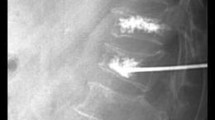Abstract
The purpose of the present study was to ascertain chronological changes in the analgesic effects of percutaneous vertebroplasty (PVP) on osteoporotic vertebral compression factures and to radiologically follow new compression fractures after PVP. Seventy-six patients (206 vertebral bodies) were followed radiologically for a mean of 11.5 months. A visual analog scale (VAS; 0–10) was used to assess pain severity, and frontal and lateral plain radiographs of the thoracic and lumbar vertebrae were taken 1–3 days and 1, 4, 10, and 22 months after PVP.
The average VAS score was 7.2 ± 2.0 (mean pain score ± standard deviation) before PVP, 2.5 ± 2.3 at 1–3 days after PVP, 2.2 ± 2.3 at 1 month, 1.9 ± 2.2 at 4 months, 1.8 ± 2.4 at 10 months, and 1.0 ± 0.2 at 22 months. A new compression fracture was confirmed in 56 vertebral bodies in 28 patients (36.8%), affecting 38 adjacent vertebral bodies (67.8%), 17 nonadjacent vertebral bodies (30.4%), and 1 treated vertebral body (1.8%). A new compression fracture occurred within 1 week of PVP in 2 vertebral bodies (3.6%), between 1 week and 1 month after PVP in 22 (39.3%), between 1 and 3 months in 12 (21.4%), between 3 and 6 months in 12 (21.4%), and after more than 6 months in 8 (14.3%). PVP was highly effective in relieving the pain associated with osteoporosis-induced vertebral compression fractures, and this analgesia was long lasting. Radiological follow-up observation revealed new compression fractures in about one-third of patients. More than half of these new compression fractures occurred in adjacent vertebral bodies within 3 months of PVP.


Similar content being viewed by others
References
Galibert P, Deramond H, Rosat P, et al. (1987) Preliminary note on the treatment of vertebral angioma by percutaneous acrylic vertebroplasty. Neurochirugie 33:166–168 (in French)
Deramond H, Depriester C, Galibert P, et al. (1998) Percutaneous vertebroplasty with polymethylmethacrylate: technique, indications, and results. Radiol Clin North Am 36:533–546
Jensen ME, Evanas AJ, Mathis JM, et al. (1997) Percutaneous methylmethacrylate vertebroplasty in the treatment of osteopolotic vertebral body compression fractures: Technical aspect. Am J Neuroradiol 18:1897–1904
Cyteval C, Sarrabere MP, Roux JO, et al. (1999) Acute osteoporotic vertebral collapse: open study on percutaneous injection of acrylic surgical cement in 20 patients. AJR Am J Roentgenol 173:1685–90
Cortet B, Cotton A, Boutry N (1999) Percutaneous vertebroplasty in the treatment of osteoporotic compression fractures: an open prospective study. J Rheumatol 26:2222–2228
Barr JD, Barr MS, Lemley TJ, et al. (2000) Percutaneous vertebroplasty for pain relief and spinal stabilization. Spine 25:923–928
Zoarski GH, Snow P, Olan WJ (2002) Percutaneous vertebraoplasty for osteoporotic compression fractures: quantitative prospective evaluation of long-term outcomes. J Vasc Intervent Radiol 13:139–148
Uppin AA, Hirsch JA, Centenera LV, et al. (2003 Occurrence of new vertebral body fracture after percutaneous vertebroplasty in patients with osteoporosis. Radiology 226:119–124
Lin EP, Ekholm S, Hiwatashi A, et al. (2004) Vertebroplasty: cement leakage into the disc increases the risk of new fracture of adjacent vertebral body. Am J Neuroradiol 5:175–180
Legroux-Gerot I, Lormeau C, Boutry N, et al. (2004) Long-term follow-up of vertebral osteoporotic fractures treated by percutaneous vertebroplasty. Clin Rheumatol 23:310–317
Perez-Higueras A, Alvarez L, Rossi RE, et al. (2002) Percutaneous vertebroplasty: long-term clinical and radiological outcome. Neuroradiology 44:950–954
Grados F, Depriester C, Carrolle G, et al. (2000) Long-term observations of vertebral osteoporotic fractures treated by percutaneous vertebroplasty. Rheumatology (Oxford) 39:1410–1414
Heini PF, Walchli B, Berlemann U (2000) Percutaneous transpedicular vertebroplasty with PMMA: a prospective study for the treatment of osteoporotic compression fractures. Eur Spine J 9:445–450
Mathis JM, Barr JD, Belkoff SM, et al. (2001) Percutaneous vertebroplasty: a developing standard of care for vertebral compression fractures. Am J Neuroradiol 22:373–381
Evans AJ, Jensen ME, Kip KE, et al. (2003) Vertebral compression fractures: pain reduction and improvement in functional mobility after percutaneous polymethylmethacrylate vertebroplasty: retrospective report of 245 cases. Radiology 226:366–372
Hodler J, Peck D, Gilula LA (2003) Midterm outcome after vertebroplasty: predictive value of technical and patients-related factors. Radiology 227:662–668
Kallmes DF, Jensen ME (2003) Percutaneous vertebroplasty. Radiology 229:27–36
Lindsay R, Silverman SL, Cooper C, et al. (2001) Risk of new vertebral fracture in the year following a fracture. JAMA 285:320–323
Jensen ME, Kallmes DF, Short JG, et al. (2000) Percutaneous vertebroplasty does not increase the risk of adjacent level fracture: a retrospective study. In: ASNR Annual Meeting Program. Oak Brook, (abstr). III: American Society of Neuroradiology 4
Polokeit A, Norte LP, Ferguson SJ (2003) The effect of cement augmentation on the load transfer in an osteoporotic functional spinal unit, finite element analysis. Spine 28:991–996
Berlemann U, Ferguson SJ, Nolte LP, et al. (2002) Adjacent vertebral failure after vertebroplasty: a biomechanical investigation. J Bone Joint Surg Br 84:748–752
Author information
Authors and Affiliations
Corresponding author
Rights and permissions
About this article
Cite this article
Tanigawa, N., Komemushi, A., Kariya, S. et al. Radiological Follow-up of New Compression Fractures Following Percutaneous Vertebroplasty. Cardiovasc Intervent Radiol 29, 92–96 (2006). https://doi.org/10.1007/s00270-005-0097-x
Published:
Issue Date:
DOI: https://doi.org/10.1007/s00270-005-0097-x




